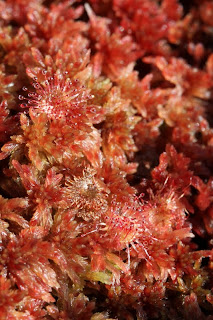In October we made our annual pilgrimage to Summer Lake, taking along a friend who had not been there before. Summer Lake is an interesting place. It has a floating bog or muskeg, the only one I know of in this area and the floating bog supports some unique and beautiful plant life.
The bog also has a floating island which can be anywhere on the lake, depending on the wind direction. Apparently this was made by fishermen many years ago and must indeed be quite old since it has good-sized trees growing on it. The picture below is of this island.
The lake is also home to a large number of non-native carnivorous plants. We have never been able to find out who originally planted them there or why, but they have established themselves around the lake. These photos show the Yellow Pitcher Plants on the far side of the lake.
The floating bog has to be reached across some more open water over a rather treacherous series of boards and old logs. The water was very high this year and all three of us fell in up to our waists and spent the rest of the day in wets shoes and boots and trousers, but no one complained.
The most prolific of the Carnivorous plants is the Yellow Pitcher Plant, Sarracenia flava. There must be several thousand of these now and they have established themselves around the southern end of the lake. These are two or three feet tall and were in flower when we saw them.
The flowers of the Yellow Pitcher Plants are very odd anyway, but this year quite a few of the flowers were deformed and appeared to have extra "pieces" where the central "plate" of the flower, some kind of stamen, I assume, is found. Perhaps the very dry summer accounts for this.
Another less striking plant is the Purple Pitcher Plant, Sarracenia purpurea. These are also found in huge clumps especially on the east side of the lake and were not in flower when we were there. They flower earlier in late August or September and we did not see them then.
The third is the White Pitcher Plant, Sarracenia leucophylla. We had thought these were dying out, but found more of them this year than ever before. The Purple Pitcher plants hug the ground as is evident from the photos, but these, like the Yellows, stand upright, though they are not as tall.
The fourth non-native is the well-known Venus Fly-trap, Dionaea muscipula. This has established itself on the far side of the lake but is not as plentiful as the others. This, too, had long finished flowering when we found it. In fact, I have not ever gone early enough to see this in flower.
There is also a native carnivorous plant growing in the bog and there are thousands of these also. It is the Round-leaf Sundew, Drosera rotundifolia. Note the wild cranberry in one of the photos. We picked and ate our fill of them while exploring since they were ripe and waiting.
We also took time, since it was a beautiful autumn day, to photograph the lake and the autumn color. The yellow patches on the other side of the lake at the Yellow Pitcher Plant, which on a sunny day really stand out against the background of the woods or water.
We also saw a number of creatures or evidence of them including a beautiful spider's web and several other tiny creatures lurking on the Pitcher Plants all unidentified The presence of spiders on these plants is a kind of double jeopardy for unsuspecting insects.






































































10 comments:
I missed this year but am now thinking of cranberry walnut scones. I used the ones I got on our trip together to make scones and they were great.
I think the snail is Cepaea nemoralis or Haplotrema vancouverense
Thanks, Marti, for the ID on the snail and for the reminder of the those wonderful scones. We gathered enough cranberries (they were very plentiful this year) for another batch of scones.
Beautiful place Ron. Precious these carnivorous. I loved the leucophylla. Great pictures, a place of dreams. Best regards
Thanks, Angel. Appreciate your comments and wish you all the best.
Ron: Very nice pics of all carnivores around the lake!!! If you would like info on how the pitcher plants and fly traps made it there, and why, I have the answers for you. I have been growing them over 30 years, and have logged a great many hours around that lake!!
and there is a stand of cobra plants present, just hidden in the shadows
I would love some answers and would love to visit the lake with you some time. We go every year once or twice.
We've heard they were there an have looked for them repeatedly but not found them.
we will have to exchange some email addresses. I discovered this gem on a school outing many many years ago and have sort of become a caretaker for the place.I can give you some info on the floating island as well.
Sorry I missed your reply. My email is ronaldhhanko @ netzero.net without the spaces.
Post a Comment